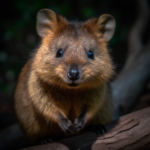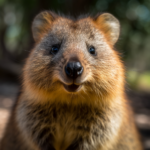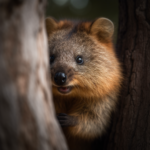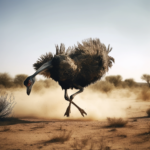The quokka, also known as the happiest animal on Earth, is a small marsupial native to Western Australia. With its adorable appearance and friendly demeanor, the quokka has captured the hearts of people around the world. In this article, we will explore the fascinating world of quokkas and delve into their lifespan, shedding light on how long these delightful creatures typically live. So, let’s dive in and discover the secrets of the quokka’s lifespan!
Key Takeaways
- The average lifespan of a quokka is around 10 years in the wild.
- Quokkas have a relatively short lifespan compared to other marsupials.
- Factors such as predation, disease, and habitat loss can impact quokka populations and their lifespan.
- Conservation efforts are important to protect quokkas and ensure their long-term survival.
Understanding Quokkas: A Brief Overview

A. Where is the Quokka From: Origin and Habitat
The quokka, a small marsupial, is native to the southwestern part of Australia. It is primarily found in the state of Western Australia, particularly on Rottnest Island, Bald Island, and in the mainland’s coastal areas. Quokkas have also been spotted on smaller islands in the region.
These adorable creatures are well-adapted to their natural habitat, which consists of dense vegetation, shrubs, and grasslands. They are most commonly found in the dense forests and scrublands of Western Australia. Quokkas prefer areas with a mix of grasses, herbs, and low shrubs, as it provides them with a diverse range of food sources.
B. Quokka Australia: The Iconic Marsupial of the Land Down Under
Quokkas are often referred to as the “happiest animal on Earth” due to their friendly and seemingly smiling facial expressions. They have become an iconic symbol of Australia and are a popular tourist attraction, drawing visitors from all over the world.
These small marsupials have a unique ability to survive in harsh conditions. They are well-adapted to the Australian climate, which can be hot and dry. Quokkas have developed efficient ways to conserve water and regulate their body temperature, allowing them to thrive in their natural environment.
C. Where Do Quokkas Live: A Glimpse into the Quokka Habitat
Quokkas primarily inhabit the southwestern corner of Australia, with the majority of the population residing on Rottnest Island. This island is known for its large quokka population, making it a popular destination for wildlife enthusiasts.
While Rottnest Island is the most well-known quokka habitat, these marsupials can also be found in other parts of Western Australia. They are known to inhabit coastal areas, including the mainland and smaller islands. Quokkas are adaptable and can survive in a variety of habitats, as long as they have access to food, water, and shelter.
Quokkas are social animals and live in small family groups or colonies. They are most active during the night, spending their days resting in shaded areas. Female quokkas are particularly active during the breeding season, as they search for suitable mates.
In order to protect the quokka population and their habitat, measures have been put in place to control the presence of predators such as foxes, cats, and feral animals. Conservation efforts and public awareness campaigns have played a crucial role in ensuring the survival of these marsupials.
Overall, the quokka’s natural habitat and behavior make it a fascinating and unique marsupial. Its ability to adapt to different environments and its friendly demeanor have made it a beloved symbol of Australia.
The Quokka Lifestyle: Eating and Mating Habits

A. Quokka Eating: A Look at Their Diet
Quokkas, those adorable marsupials native to Western Australia, have a unique diet that allows them to thrive in their natural habitat. While they may appear cute and cuddly, these small creatures are actually herbivores, meaning their diet consists mainly of plants and vegetation.
The primary food source for quokkas is grass. They graze on a variety of grasses, including tussock grass, which is abundant in their natural habitat. Quokkas also consume leaves, bark, and stems from various plants. They have been known to eat shrubs, herbs, and even the occasional fruit or seed.
One interesting fact about quokkas is that they have a unique ability to extract moisture from their food. This allows them to survive in their arid environment, where water sources may be scarce. They can obtain most of their hydration from the plants they consume, reducing their dependence on external water sources.
B. Do Quokkas Mate for Life: Insights into Their Reproductive Behavior
Quokkas are known for their social nature, and this extends to their reproductive behavior as well. While they do not mate for life, they engage in a complex mating system that involves multiple partners.
During the breeding season, which typically occurs between January and March, male quokkas compete for the attention of females. They engage in aggressive behaviors such as boxing and biting to establish dominance and secure mating opportunities.
Once a male has successfully courted a female, they will mate and then go their separate ways. Female quokkas have a unique reproductive ability called embryonic diapause, which allows them to delay the development of their fertilized eggs. This adaptation ensures that the young are born during favorable conditions, such as when food is abundant.
After a gestation period of around 27 to 28 days, the female gives birth to a single joey. The joey then spends the next six to seven months in its mother’s pouch, where it continues to develop and grow. Once it becomes too large for the pouch, the joey will ride on its mother’s back until it becomes independent.
It’s worth noting that quokkas have a relatively short reproductive lifespan, with females typically ceasing to reproduce around the age of five to six years. This, coupled with other factors such as predation and disease, can impact the overall population longevity of quokkas.
In conclusion, quokkas have fascinating eating and mating habits that contribute to their unique lifestyle. Their herbivorous diet allows them to adapt to their environment, while their complex mating system ensures the continuation of their species. Understanding these behaviors is crucial for the conservation and protection of these adorable marsupials.
The Life Cycle of a Quokka: From Birth to Maturity

A. The Early Life: Birth and Juvenile Stage
The early life of a quokka is filled with fascinating milestones as they navigate their way through the world. Let’s take a closer look at the birth and juvenile stage of these adorable marsupials.
-
Birth: Quokkas are marsupials, which means that they give birth to relatively undeveloped young and carry them in a pouch. After a gestation period of around one month, the female quokka gives birth to a tiny, hairless joey, which is about the size of a jelly bean. The joey then crawls into its mother’s pouch, where it will spend the next six to seven months developing and growing.
-
Pouch Life: During the early stages of its life, the joey relies entirely on its mother for nourishment and protection. It attaches itself to one of the four teats inside the pouch, where it feeds on milk for several months. As the joey grows, it gradually starts to explore the world outside the pouch, venturing out for short periods before returning to the safety of its mother’s pouch.
-
Juvenile Stage: Around seven months of age, the quokka joey becomes more independent and starts to spend more time outside the pouch. During this stage, the young quokka learns essential skills such as foraging for food, socializing with other quokkas, and navigating its surroundings. The juvenile quokka will continue to stay close to its mother for guidance and protection until it reaches maturity.
B. The Adult Quokka: Maturity and Reproduction
As a quokka reaches adulthood, it undergoes significant changes in its behavior and physiology. Let’s explore the fascinating world of adult quokkas and their journey towards reproduction.
-
Maturity: Quokkas reach sexual maturity at around one to two years of age. At this stage, they are fully grown and capable of reproducing. Male quokkas become more territorial, marking their territory with scent glands and engaging in aggressive displays to establish dominance. Female quokkas become sexually receptive and are ready to mate.
-
Reproduction: Quokkas have a unique reproductive system. Females have a short window of fertility, known as estrus, which lasts only a few days each year. During this time, multiple males compete for the opportunity to mate with the female. The male quokkas engage in fierce battles, using their hind legs to kick and box each other. The dominant male eventually mates with the female, ensuring the survival of his genes.
-
Parenting: After a gestation period of about one month, the female quokka gives birth to a single joey. Unlike other marsupials, quokkas do not have a permanent pouch. Instead, the joey attaches itself to the mother’s teat, which is located outside the pouch. The mother provides care and protection to her joey until it becomes independent.
C. Aging Quokkas: The Final Stages of Their Life Cycle
As quokkas age, they face various challenges and changes in their physical and social lives. Let’s delve into the final stages of a quokka’s life cycle and the factors that can influence their longevity.
-
Aging Process: Quokkas have a relatively short lifespan compared to other marsupials. In the wild, they typically live for about 10 years, while those in captivity may live slightly longer. As they age, quokkas may experience a decline in their physical abilities and overall health. They may become more vulnerable to diseases and predators, which can impact their survival.
-
Threats and Predators: Quokkas face several threats in their natural habitat. Predation by introduced species such as foxes, cats, and feral dogs poses a significant risk to their survival. Additionally, habitat loss and fragmentation due to human activities can disrupt their populations. Conservation efforts and raising awareness about the importance of protecting quokka habitats are crucial for their long-term survival.
-
Population Longevity: The quokka population is currently stable, but ongoing research is essential to monitor their numbers and understand the factors that influence their longevity. Scientists study the health and behavior of quokkas to gain insights into their population dynamics and develop strategies for their conservation.
In conclusion, the life cycle of a quokka is a remarkable journey filled with unique adaptations and challenges. From the early stages of birth and pouch life to the complexities of adulthood and reproduction, quokkas demonstrate incredible resilience in their natural habitat. Understanding their life cycle and the factors that affect their lifespan is crucial for ensuring the long-term survival of these charismatic marsupials.
The Quokka Lifespan: In-Depth Analysis
A. What is a Quokka’s Lifespan: An Overview
The lifespan of a quokka, a small marsupial native to Western Australia, is a topic of interest for many wildlife enthusiasts. Understanding the lifespan of these adorable creatures can provide valuable insights into their biology and conservation needs.
On average, quokkas have a lifespan of about 10 years in the wild. However, some individuals have been known to live up to 15 years. In captivity, where they are protected from predators and have access to a consistent food supply, quokkas can live even longer, with some reaching 17 years of age.
B. Quokka Lifespan in the Wild vs. Captivity
Quokkas in the wild face numerous challenges that can impact their lifespan. Their natural habitat is under threat due to human activities, such as urbanization and habitat destruction. Additionally, predation by introduced species like foxes and feral cats poses a significant risk to quokkas.
In captivity, quokkas are shielded from these threats and provided with a controlled environment. They receive regular veterinary care, a balanced diet, and protection from predators. These factors contribute to an increased lifespan for captive quokkas compared to their wild counterparts.
C. Factors Affecting the Quokka Lifespan
Several factors can influence the lifespan of quokkas, both in the wild and in captivity. These factors include:
-
Health: Quokkas that maintain good overall health are more likely to live longer. Regular check-ups, vaccinations, and proper nutrition are essential for their well-being.
-
Aging Process: As with any living organism, quokkas experience the effects of aging. The aging process can lead to a decline in physical abilities and increased vulnerability to diseases.
-
Survival Rate: Quokkas face various threats in their natural habitat, such as predation and disease. Higher survival rates among individuals can contribute to a longer average lifespan for the population.
-
Natural Habitat: The availability of suitable habitat is crucial for quokkas. Loss of habitat can lead to a decrease in population size and limit their access to food and resources.
-
Predators: Quokkas have natural predators, including foxes and feral cats. The presence of these predators can significantly impact the quokka population and their lifespan.
Understanding these factors is vital for conservation efforts aimed at protecting quokkas and ensuring their long-term survival. By addressing the threats they face, such as habitat loss and predation, we can help increase their lifespan and maintain healthy populations.
In conclusion, the lifespan of a quokka can vary depending on various factors, including their environment, health, and the presence of predators. While the average lifespan of a quokka in the wild is around 10 years, those in captivity can live even longer. By studying and addressing the factors that affect their lifespan, we can contribute to the conservation of these unique and charismatic marsupials.
The Quokka Population: Current Status and Conservation Efforts
A. Quokka: How Many Left in the Wild and in Captivity
The quokka, a small marsupial native to Western Australia, is known for its friendly and photogenic nature. However, despite its adorable appearance, the quokka population is facing significant challenges. While there is no precise count of the quokka population, estimates suggest that there are around 8,000 to 17,000 quokkas remaining in the wild.
In terms of captivity, the number of quokkas is relatively small. They are not commonly found in zoos or wildlife parks outside of Australia. However, some conservation organizations and sanctuaries have successfully bred and housed quokkas in captivity to help protect the species and raise awareness about its conservation needs.
B. Threats to the Quokka Population
The quokka population faces several threats that contribute to its declining numbers. One of the primary threats is habitat loss. Quokkas rely on specific habitats, such as dense vegetation and shrublands, for their survival. However, urbanization, land clearing, and agriculture have resulted in the destruction and fragmentation of their natural habitat, limiting their ability to find suitable food and shelter.
Another significant threat to the quokka population is predation. Quokkas have natural predators, including foxes and feral cats, which can prey on them and their young. These introduced predators pose a significant risk to the quokka population, as they are not adapted to defend themselves against such threats.
Additionally, diseases can have a devastating impact on the quokka population. While quokkas are generally resilient animals, outbreaks of diseases like anthrax can cause mass deaths within colonies. Furthermore, the introduction of diseases by other animals can also pose a risk to the quokkas.
C. Conservation Efforts: Ensuring the Quokka’s Survival
To protect the quokka population and ensure its long-term survival, various conservation efforts are underway. These efforts focus on addressing the threats faced by quokkas and promoting their conservation in both the wild and captivity.
-
Habitat Protection: Conservation organizations work to protect and restore quokka habitats, ensuring that they have sufficient food, water, and shelter. Efforts are made to minimize habitat destruction and create wildlife corridors to connect fragmented habitats, allowing quokkas to move freely.
-
Predator Control: To mitigate the impact of predators, conservation programs implement strategies to control and manage foxes and feral cats. This includes trapping, baiting, and other methods to reduce their numbers and limit their impact on quokka populations.
-
Disease Monitoring and Prevention: Regular monitoring of quokka populations helps identify and address disease outbreaks promptly. Vaccination programs and disease prevention measures are implemented to minimize the risk of diseases spreading among quokkas.
-
Public Awareness and Education: Raising awareness about the quokka’s conservation status is crucial for garnering public support. Educational campaigns, guided tours, and responsible tourism initiatives help promote understanding and appreciation for quokkas and their habitat.
-
Research and Monitoring: Ongoing research and monitoring programs provide valuable insights into the quokka population, their behavior, and the effectiveness of conservation efforts. This information helps guide future conservation strategies and ensures the continued success of quokka conservation initiatives.
By implementing these conservation efforts, we can work towards securing a brighter future for the quokka population. It is essential to recognize the importance of preserving not only this adorable marsupial but also the unique ecosystems they inhabit. Through collective action and continued dedication, we can help protect the quokka and ensure its survival for generations to come.
The Quokka and Humans: A Complex Relationship
A. Can a Quokka Kill You: Debunking Myths and Misconceptions
The quokka, a small marsupial native to Western Australia, has gained significant attention in recent years due to its adorable appearance and friendly demeanor. However, there are several myths and misconceptions surrounding these creatures, including the notion that they can be dangerous or even deadly to humans. Let’s take a closer look at the truth behind these claims.
1. Quokkas are not aggressive predators
Contrary to popular belief, quokkas are not aggressive animals. They are herbivores, primarily feeding on grasses, leaves, and bark. Their diet consists mainly of plants, making them harmless to humans. Quokkas do not possess the physical attributes or hunting instincts necessary to pose a threat to humans.
2. Quokkas are not venomous
Another misconception is that quokkas carry venom or transmit diseases that can harm humans. This is simply not true. Quokkas do not possess any venomous glands or produce toxins that could be harmful to humans. They are not carriers of diseases that can be transmitted to humans either.
3. Quokkas are not prone to attacking humans
While quokkas are generally friendly and curious, they are not known to attack humans unprovoked. In fact, they are more likely to retreat or flee when faced with a potential threat. Quokkas have a natural instinct to avoid conflict and will typically only defend themselves if they feel cornered or threatened.
B. How to Own a Quokka: Legalities and Responsibilities
Given their adorable appearance and friendly nature, it’s understandable that some people may be tempted to own a quokka as a pet. However, it’s important to understand the legalities and responsibilities involved in owning a quokka.
1. Quokkas are protected wildlife
Quokkas are classified as protected wildlife in Australia, and it is illegal to keep them as pets without the appropriate permits and licenses. These regulations are in place to ensure the conservation and preservation of quokka populations in their natural habitat.
2. Quokkas require specialized care
Even if it were legal to own a quokka, they are not suitable as pets for the average person. Quokkas have specific dietary and environmental needs that can be challenging to meet in a domestic setting. They require a diet rich in vegetation, access to open spaces for exercise, and a climate similar to their natural habitat.
3. Supporting quokkas in their natural habitat
Instead of trying to own a quokka, individuals can support the conservation efforts aimed at protecting these unique creatures. By donating to reputable organizations or participating in ecotourism activities, individuals can contribute to the preservation of quokka populations and their natural habitat.
In conclusion, quokkas are not dangerous animals and do not pose a threat to humans. They are gentle herbivores that play an important role in their ecosystem. While it may be tempting to own a quokka as a pet, it is essential to respect their protected status and support their conservation in their natural habitat.
Conclusion
In conclusion, the quokka is a fascinating and unique marsupial native to Western Australia. Despite its small size, the quokka has captured the hearts of many with its adorable appearance and friendly demeanor. While the exact lifespan of a quokka in the wild is not well-documented, it is estimated to be around 10 years. However, in captivity, quokkas have been known to live up to 15 years or even longer. Factors such as predation, habitat loss, and disease can impact the quokka population and their lifespan. Efforts are being made to protect and conserve these delightful creatures, ensuring that future generations can continue to enjoy their presence. So, next time you come across a picture of a smiling quokka, remember that these little creatures have a limited time on this Earth, and it is our responsibility to protect and preserve their habitat for generations to come.
Frequently Asked Questions
Q1: What is a Quokka’s lifespan?
A: The average lifespan of a quokka is around 10 years in the wild. However, in captivity, they can live up to 15 years due to better living conditions and medical care.
Q2: Where is the Quokka from?
A: Quokkas are native to Australia. They are primarily found on smaller islands off the coast of Western Australia, particularly on Rottnest Island and Bald Island.
Q3: Can a Quokka kill you?
A: No, a quokka cannot kill you. They are small, herbivorous marsupials and are generally not dangerous to humans. However, they can bite or scratch if they feel threatened.
Q4: Where do Quokkas live?
A: Quokkas live in Australia, specifically on the small islands off the coast of Western Australia. Their primary habitats are Rottnest Island and Bald Island.
Q5: What is the life cycle of a Quokka?
A: The life cycle of a quokka begins with birth after a month-long gestation period. The newborn, called a joey, stays in the mother’s pouch for about six months. After leaving the pouch, the joey continues to nurse for two more months. Quokkas reach sexual maturity at about one and a half years of age.
Q6: How many Quokkas are left?
A: The exact number of quokkas left is unknown, but it’s estimated to be around 8,000-12,000. They are listed as vulnerable by the IUCN due to habitat loss and predation by introduced species.
Q7: How long do Quokkas live?
A: Quokkas typically live for about 10 years in the wild. However, in captivity, they can live up to 15 years.
Q8: What is a Quokka’s diet and how does it affect their lifespan?
A: Quokkas are herbivores and their diet mainly consists of grasses, leaves, and bark. A balanced diet contributes to their overall health and longevity. However, feeding quokkas anything other than their natural diet can harm their health and potentially shorten their lifespan.
Q9: Do Quokkas mate for life?
A: No, quokkas do not mate for life. They have a polygynous mating system, where a single male mates with multiple females.
Q10: How can I own a Quokka?
A: It’s illegal to own a quokka as a pet. They are protected by law in Australia and any attempt to handle or feed them can result in hefty fines. Their conservation and well-being are of utmost importance.




